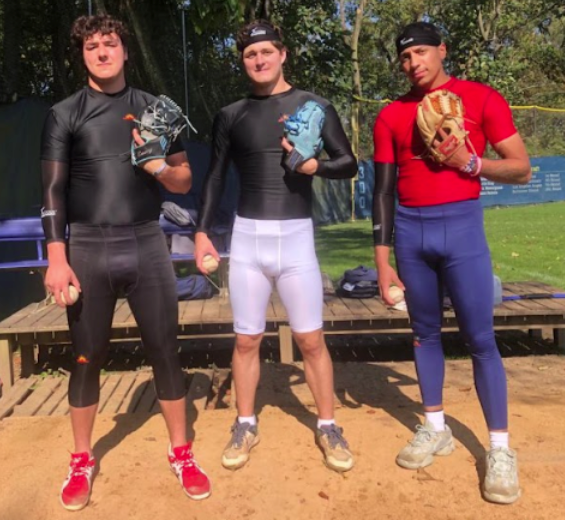Improve Shoulder and Rotator Cuff Pain with Qualified Compression Garments
For regularly active people, such as athletes and gym-goers, shoulder and rotator cuff pain poses a serious threat. Particularly, when working the upper body, not having the proper form and attire can leave you with a sore muscle or, worse, a shoulder injury. Either way, it’s not a pleasant feeling, and it may limit your activity while you recover.
SWEAT IT OUT® with COOL COMPRESSION® Technology carries a variety of high-quality compression apparel. All of our compression garments are Made-in-USA and are proven to help during recovery and rehabilitation. We encourage you to wear our compression garments while working out to avoid a serious injury from occurring in the first place. THINK PREVENTION!
What Causes Shoulder and Rotator Cuff Pain?
Ultimately, when it comes to shoulder pain, there are various underlying causes. We’ve listed a few for your consideration below, but, ultimately, you should consult with a doctor if you experience serious pain or chronic discomfort in your shoulder and rotator cuff area.
- Shoulder Dislocation — If the arm comes out of its socket and is over-rotated, you may have a dislocation in your shoulder. You may feel pain, swelling, and even numbness as a result.
- Impingement — Caught tendons can lead to a rotator cuff injury. With that, the range of motion may become limited, and swelling can follow.
- Bursitis – Repeated shoulder motion can cause irritation or inflammation of the bursa sac, leading to pain and swelling.
- Fracture – Enough impact to the shoulder region can leave behind a broken bone or fracture. Humerus and clavicle fractures are the most common in this area, both of which can affect the strength and mobility of the shoulder.
- Rotator Cuff Tear – Like some of the other conditions above that can develop with overuse, the same can be said for a rotator cuff injury. Those who have this condition may experience discomfort when lifting items.
- Cartilage Injury – Cartilage, which surrounds the shoulder joint for extra cushioning, can be injured when coming in contact with a lot of force. This is typically associated with weakness and mobility issues as a result of the discomfort.
- Separation – Finally, separation occurs when there’s a disconnection between the shoulder blade and collarbone or acromioclavicular (AC) joint. In circumstances when the collarbone is pushed out of alignment, you may develop a shoulder bump.
All of these conditions can cause moderate to significant pain to those experiencing them. Many of these can be sports-related injuries, but if you find yourself experiencing any of the symptoms above, it’s best to consult a doctor.
Are You Prone To Shoulder Issues?
Those that live active lifestyles know that shoulder pain can develop over time with extensive repetitive training. Especially in sports that involve a lot of elbow or arm movements, you may be more prone to developing rotator cuff pain.
- Baseball
- Basketball
- Golf
- Football
- Tennis
- Boxing
- And more
How Does Shoulder Pain Affect Daily Activities?
Besides the elements mentioned above, shoulder pain can lead to trouble performing necessary daily activities. This includes bathing, brushing your hair, getting dressed, lifting objects, and more. It can also take away from some of the joys in life, such as sports activities, social opportunities, and even relaxing recreational activities.
How Can Compression Gear Aid With Shoulder and Rotator Cuff Pain?
For those who find themselves with general shoulder discomfort, compression gear can reduce swelling and offer the necessary support to help avoid a serious injury and accelerate the recovery process.
Let’s take a further look at how SWEAT IT OUT® with COOL COMPRESSION® Technology can benefit you:
COOL COMPRESSION® Technology garments are even recommended by physicians, chiropractors, and athletic trainers! However, in the case of a serious injury, it is best to consult with a doctor first — compression gear does not replace medicine!
Choose compression shirts from SWEAT IT OUT® with COOL COMPRESSION® technology to expedite recovery for shoulder and rotator cuff soreness or injury. The Performance Compression Short-Sleeve Shirt for Men and Women (Style 3020) allows you to move freely without feeling uncomfortably constrained. It also reduces swelling and muscle vibrations that can lead to pain. Similarly, the Improved Posture Performance Short-Sleeve Compression Shirt for Men and Women (Style 3023) trains the back and neck to correct any postural issues, which in turn can reduce shoulder strain and pain. For best results, wear from morning until night for two weeks — do not wear at night while sleeping.
Get Relief
Once you have the clearance from your doctor, you can go ahead to stock up on the right products for additional shoulder and rotator cuff support.
Shop compression apparel, all Made-in-USA at SWEAT IT OUT® today!
Call Us: 866-385-1310 or 800-343-8960
Visit Us: https://sweatitout.com/
The post Improve Shoulder and Rotator Cuff Pain with Qualified Compression Garments appeared first on SWEAT IT OUT® COOL COMPRESSION®.









